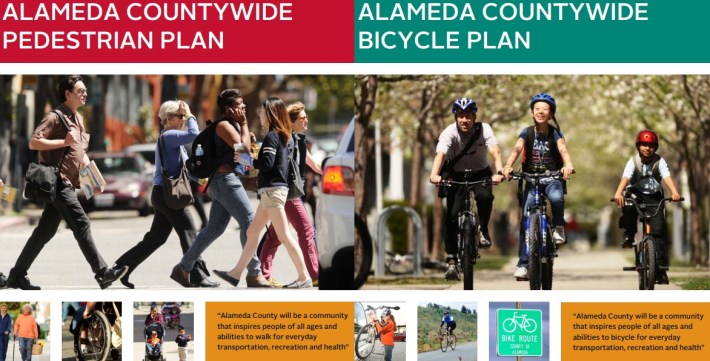In theory, the East Bay has nearly perfect terrain for bicycling. Streets slope gently east for miles from the Bay, and once over the hills, pedaling conditions are almost idyllic -- that is, if you feel safe enough to ride.
The East Bay, like much of the country, was built for cars rather than for walking or bicycling. Navigating fast-moving streets like Shattuck Avenue, Telegraph Avenue, and International Boulevard can be dangerous. And for pedestrians, uneven sidewalks (if they exist) and poorly-marked crosswalks convey a message: no walkers here.
Fortunately, streets in Alameda County could become friendlier for walking and bicycling with its new Bicycle and Pedestrian Plans, set to be approved early next month. The Alameda County Transportation Commission released the final drafts of the plans on Monday, laying out a new vision to make urban centers and transit hubs easier to reach on foot and bike, and to provide off-road trails to help intercity commuters cover longer distances.
While some cities like Oakland and Berkeley have for years been making improvements like bicycle boulevards, bike lanes, signage, multi-use trails, and sidewalk repairs, the approach taken in the bike and pedestrian plan updates could make cities in Alameda County even friendlier for car-free travel, if local agencies follow through with it.
The plans call for a dense network of bike lanes, bike boulevards, sharrows, and signs, along with inviting sidewalks and crosswalks in much of the East Bay. The goal is to improve 762 miles of bike routes and 2,779 miles of pedestrian walkways by 2040.
Some of the biggest projects in the plans include pedestrian bridges over highways and completion of paths dedicated to bikers and walkers. In total, the plan would cost an estimated $2.7 billion.
Planners hope the improvements will increase bike and pedestrian mode shares throughout the county -- currently two percent for biking (half the Bay Area average) and 11 percent for walking. But the plan still falls short of setting measurable targets for increasing mode share, according to Dave Campbell, program director for the East Bay Bicycle Coalition.
While the county diligently tracks car traffic counts and sets standards for pavement conditions, agencies don't track progress in walking and biking improvements in a way that holds them accountable for implementing their plans, said Campbell. “Quite frankly, it’s unacceptable," he said.
Aside from the lack of targets, Campbell praised the plan for using a more effective approach than that taken previous iterations. “It’s a better plan, a better way of looking at how bike and walking trips are made and what the network should look like to accommodate them," he said.
A major change with the new plans is that they focus on new local walking and biking networks, which are aimed at improving conditions for short trips to transit stations, workplaces, and downtown shopping destinations. Whereas previous plans focused on longer intercity routes throughout the county, bicycle and pedestrian advocates say the new approach fits with how people typically travel on bikes or on foot -- to dense, urban centers or transit stops within a few miles of where they live. According to data in the plans, three-fourths of all bike trips in the county cover four miles or less, while about three-fourths of all walking trips cover one mile or less.
“Nobody is riding from one employment center to another employment center,” said Campbell. “That’s not what people do. They ride from their homes.”
City planners showed a similar enthusiasm for the local approach. “It reflects a positive development and what a countywide bike plan should look like,” said Jason Patton, the bicycle and pedestrian program manager for Oakland’s Public Works Agency. “We want to capture people who live close to the BART station, or close to downtown Oakland.”
The Alameda County bicycle and pedestrian plans designate downtown areas and transit hubs for BART, Amtrak and AC Transit as priority zones for investing in street improvements, along with dense, lower-income areas known as “communities of concern." Patton said the new plan has the potential to have the biggest impact in dense, transit-oriented cities like Oakland, Berkeley and Emeryville.
Policies laid out in the new bike and pedestrian plans would also set funding priorities for the large and diverse region within Alameda County, which includes 14 cities and unincorporated communities with a population of more than 1.5 million.
While projects are ultimately implemented by cities, the county is responsible for doling out the funds. To help grow the funding pot for bike and pedestrian improvements, advocates are pushing Measure B1, which, if approved by voters in November, would double the county's existing transportation sales tax from half-a-cent to one full cent, leading to a significant increase in revenue available for bike and pedestrian projects.
More broadly, the new plans help to coordinate improvements to bike and pedestrian connections between cities and helps set the direction for local city plans. Patton also said that by instituting official policies to improve streets for bicycling and walking, rather than treating them as an afterthought, the policies get a little stronger in practice.
Pedestrian and bicycle improvements are "becoming a more integral consideration with the day-to-day work of government agencies," said Patton. "That’s really how we’re going to get to where we need to be. If we want people to walk and bike as part of their lives, we need that reflected in all the decisions that are made.”






